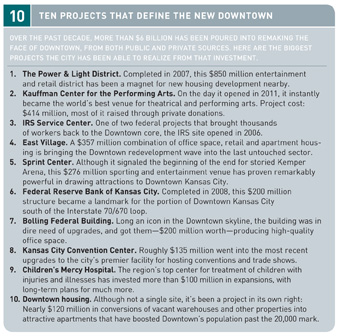Kansas City Downtown: Hitting Stride
From almost any perspective, Kansas City's Downtown is hitting a stride that is truly impressive. The natural question: Where do we go from here?
by Dale Garrison

For several years, Kansas City has achieved a high ranking as a place to visit, a hot convention locale, as well as an outstanding place for residents and businesses. The area is home to world-class fine arts, nationally recognized entertainment venues and amenities like dining options that have earned accolades from some of the nation’s top critics.
Forbes magazine recently recognized Downtown Kansas City as one of the Top 10 downtowns in America. Earlier, Frommers named Kansas City a Top 10 Travel Destination for 2012—the only U.S. city on the list. Travel + Leisure listed Kansas City the most Affordable Getaway in the U.S., while Under30CEO.com named Kansas City the No. 2 city in America for young entrepreneurs.
Historic Start
So where did all of this come from? Well, none of it happened overnight. In the mid-1990s, Downtown Kansas City was largely a collection of empty parking lots, empty warehouses and scattered businesses surrounding a few blocks of offices that loyally remained in the city’s dwindling core.
The first steps saw warehouses converted into lofts and other uses. That began a small, but significant, reversal to a decades-long exodus from the area. Larger renovations, including many that used historic tax credits, brought more businesses and lofts, not only adding to the region’s economic base but rebuilding its population from a few thousand to the current 20,000-plus.
The biggest steps came in 2005–2007, with announcement of public-private partnerships that brought the distinctive H&R Block headquarters building, the Sprint Center and the Power & Light Entertainment District. The 2011 opening of the truly world-class Kauffman Center for the Performing Arts was icing on a $6 billion downtown redevelopment cake.
Broad Foundation
The breadth and depth of this is larger in several ways. Downtown Kansas City may be unique in its boundaries, which are usually defined as a six-mile corridor from the River Market District to the Country Club Plaza. This swath of the urban core has always included recognized jewels like the world-famous Plaza, but the sheer size of the region has been a challenge to fill for a metropolitan area of just over 2 million people. Today, that sprawling space is becoming a strength because of its diverse opportunities.
One of the latest steps is a good example. The southern end of the Downtown core has until recently been Crown Center, a collection of luxury hotels and shopping near the beautifully restored Union Station. Except for the $200 million Federal Reserve Bank building opened in 2008, there was a two-mile gap of under-utilized and blighted buildings between Crown Center and the Country Club Plaza. Today, that area is being pursued by developers who continue the trend of remaking older properties into new business and apartment locations, while connecting two of Downtown’s hottest areas.
Eastern Promises
Another dramatic step is under way in the last large undeveloped portion of the Downtown Loop. The East Village is an eight-block area that ultimately calls for 1,200 units of mixed-income housing and street-level retail. The 2009 opening of the new J.E. Dunn headquarters was the first component, with a 185,000-square-foot building that completes the enclosure of the civic mall and serves as an anchor for surrounding East Village neighborhoods. Residential components opened in 2011 when Swope Community Builders unveiled East Village Apartments, the first of several residential projects.
Like Midtown projects, East Village is significant in itself, but it is also vital for the connections it makes between rebounding Downtown and areas just outside the immediate development. While filling blocks of blighted buildings and empty lots with new business and residences, the redevelopment also better connects Downtown directly with areas such as the growing Kansas City University of Medicine and Biosciences on the edge of the rebounding Northeast District.

Economic Flexibility
The university, one of three medical schools in and around Downtown, is also an example of the diverse economic base in the metro region’s core. In health care, other examples focus on Hospital Hill, where Truman Medical Center and Children’s Mercy Hospital operate large and growing facilities. Nearby, the University of Missouri–Kansas City also houses its nationally recognized medical and dental programs.
UMKC, already a key player in this neighborhood with its schools of medicine, dentistry, pharmacy and nursing, may play a significant part in one of the Downtown’s next big steps. The Greater Kansas City Chamber of Commerce identified as one of its “Big Five” ideas the possibility of creating a centralized UMKC performing arts campus Downtown. While bringing up to 1,000 students Downtown would have significant impact by itself, the idea has sparked discussion of further arts developments in a setting that already boasts the Kauffman Center.
And there’s more: Like Kansas City itself, Downtown benefits from an increasing web of economic factors that range from human and animal sciences to international logistics.
With these successes and more, it’s not just a saying: Everything really is up to date in Kansas City—and the outlook for the future appears very bright
Return to Ingram's September 2012